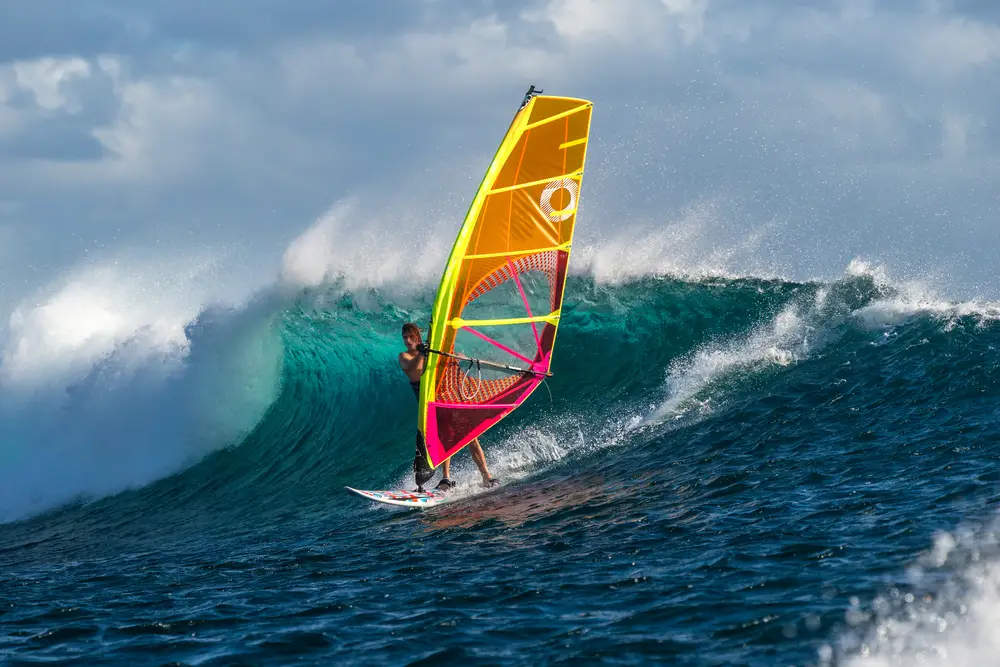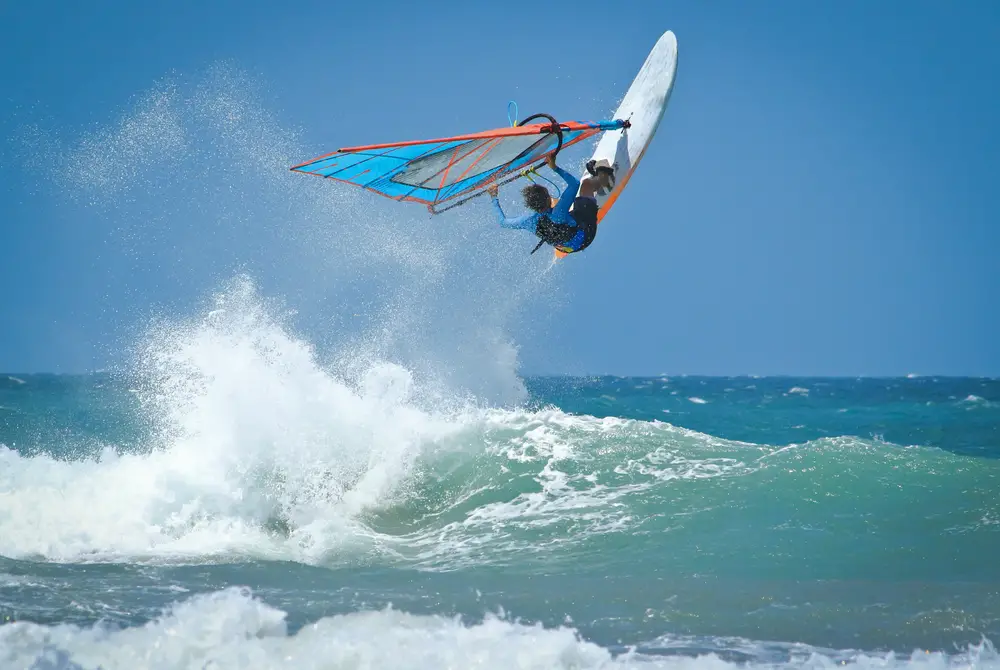windsurfing is a water sport that combines surfing and sailing, as it takes place on a board. This sport, which emerged in the 1960s, has many fans because it is a unique combination of adrenaline, technique and direct contact with nature;
The practice of windsurfing requires knowledge of a series of technical terms and specific equipment. So, to get to grips with the sport, you need to understand what each of these words means. This knowledge allows you to perform the maneuvers, adjust the equipment and, of course, ensure safety during practice.
To help you with this knowledge, we’ve created the windsurfing glossary! In this list, you’ll learn about the main terms used in the sport and what each one means. Check it out!

Open your Betano account and get up to 1,000 reais in bonuses.
Payments via PIX, live games and super odds!
Click here to open your account!
Windsurfing glossary: complete list
- Anchor
- Bursting
- Balloon
- Windward
- Boom
- Edge
- Cambar
- Carve
- Catapult
- Downhaul
- Finca-pé
- Foil
- Freeride
- Funboard
- Gibe
- Harness
- Hook In
- Hydrofoil
- Jibe
- Launch
- Carry
- Mast
- Ripple
- Planar
- Stern
- Rig
- Slalom
- Trapeze
- Upwind
- Sail
Windsurfing glossary: get to know the terms
Anchor
The anchor is a device used to keep the windsurfing board in a specific place, especially in areas where the wind can easily move it.
Breaking
Breaking is the area where the waves begin to break as they approach the shore. It’s a critical zone for the athlete, as it requires skills to cross the waves without falling off the board.
Balloon
Ballooning is a maneuver performed in a curve at high speed, taking advantage of the wind to gain momentum and change direction quickly.
Windward
Windward is the side where the wind is coming from in relation to a specific point, and is crucial for aligning the board and sail correctly to the wind.
Boom
The boom is the name given to the horizontal bar held by the hands to control the sail. It is adjustable and connects to the mast, allowing the sail to be steered.
Edge
Edge is the term that defines the side of the board that is in contact with the water. There are two types of edge: starboard (right) and port (left), both of which are essential for navigation and maneuvering.
Tacking
Tacking is the maneuver of changing direction by passing the sail from one side of the board to the other. It is an essential technique for changing course and adjusting to wind conditions.
Carve
Carve is a technique for turning the board smoothly and continuously while maintaining speed. It is often used in advanced maneuvers and to maintain control in strong wind conditions.
Catapult
The catapult happens when the athlete is thrown forward after a sudden movement of the board or loss of control of the sail.
Downhaul
The downhaul is the cable used to tension the base of the sail to the mast. Adjusting the downhaul correctly is essential to optimize the shape of the sail and improve performance in different wind conditions.
Footrest
The footrest is the support on the board for placing your feet and having greater control and stability.
Foil
Foil is an accessory that is attached to the bottom of the board, allowing the athlete to rise above the water, reducing friction and increasing speed.
Freeride
Freeride is a style of windsurfing practiced just for fun.
Funboard
Funboard is a type of windsurfing board that combines characteristics of wave and slalom boards, bringing versatility to different wind and wave conditions.
Gibe
Gibe is the name given to the maneuver of turning the board to change direction by moving the stern (back) of the board through the wind.
Harness
The harness is the name of a safety belt worn around the waist. It is connected to the sail via cables, helping to distribute the force of the wind and allowing for greater control and reduced physical effort.
Hook In
Hook in is the action of attaching the harness to the boom cables, providing a more stable connection with the sail and relieving tension on the booms.
Hydrofoil
Hydrofoil is a specific type of foil that allows the windsurf board to rise above the water more efficiently.
Jibe
Jibe is the term given to a maneuver in which the athlete changes the direction of the board by moving the stern through the wind.
Start
The start is the initial moment of a race when the athlete begins to move through the water.
Mast
The mast is the name given to the sail’s mast, a vertical component that supports the sail and allows it to catch the wind.
Swell
Ripples are the waves that haven’t broken yet, but which influence navigation and the stability of the board.
Planing
Planing is the condition of windsurfing in which the board glides over the surface of the water with minimal resistance, allowing for high speed.
Stern
Stern is the name of the back of the windsurfing board. Understanding its dynamics is extremely important for maneuvers such as the jibe, and also for maintaining control of the board in different situations.
Rig
Rig is the complete set of sail, mast, boom and cables used in windsurfing. Setting up and adjusting the rig correctly is essential to optimize the athlete’s performance and maintain safety.
Slalom
Slalom is a windsurfing discipline that focuses on speed and the execution of fast maneuvers around buoys or markers. It requires the use of specific boards and sails, as well as high technical skill on the part of the athlete.
Trapeze
Trapeze is the safety belt used in windsurfing, very similar to the harness, which helps to distribute the force of the wind through the athlete’s body, allowing for greater control and reduced effort.
Upwind
Upwind is steering against the wind. Sailing upwind requires knowledge of specific techniques to maintain the course and optimize the efficiency of the equipment.
Sail
The sail is the main component of windsurfing, as it is what captures the wind and propels the board. There are different types of sails, each designed for specific wind conditions and sailing style.

Windsurfing glossary: complete list
- Anchor
- Bursting
- Balloon
- Windward
- Boom
- Edge
- Cambar
- Carve
- Catapult
- Downhaul
- Finca-pé
- Foil
- Freeride
- Funboard
- Gibe
- Harness
- Hook In
- Hydrofoil
- Jibe
- Launch
- Carry
- Mast
- Ripple
- Planar
- Stern
- Rig
- Slalom
- Trapeze
- Upwind
- Sail
Windsurfing glossary
If you enjoyed learning about the glossary of windsurfing and the main words used in the sport, take the opportunity to check out our other special content on the subject.
Here you can see lists, glossaries, rankings, special articles, news and much more about the world of sport!



